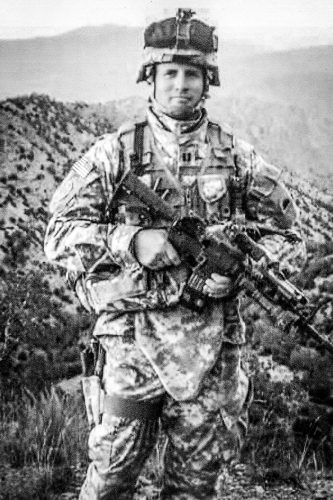
By Camilla Mortensen and Taylor Perse
“An indeterminate distance, perforating gunshot wound pathway involves the head and neck. The entrance wound defect is present over the left preauricular area of the face, 5 1/2 inches below the top of the head and 1 1/2 inches anterior to the left ear canal. The defect itself is roughly circular in shape and measures 5 mm in average diameter.”
The “defect itself” refers to the gunshot wound to the head that killed Brian Babb.
While the autopsy gives the stark details of Babb’s corpse, what is still unresolved for his family is why the police shot the 49-year-old military veteran with PTSD.
McGowan et al v. Stutesman et al goes to trial Feb. 18. A pre-trial conference was held before Judge Michael McShane at the federal courthouse in Eugene on Feb. 11.
The plaintiffs in the $7.5 million lawsuit include Lee Babb, Brian Babb’s father and a former executive with Delta Sand and Gravel, and Stephanie Woodcook, Brian Babb’s ex-wife and the mother of the other two plaintiffs, 20-year-old Connor Babb and 24-year-old Kaylee Babb, who were still in their teens when their father was killed.
The defendants are the city of Eugene and William Stutesman, the Eugene police officer who pulled the trigger.
On March 30, 2015, Babb was armed and feeling suicidal, according to court documents. He had fired his pistol in his house on Devos Street in Eugene, and he told his therapist, Becky Higgins, as much when he called her.
Higgins then called the Eugene Police Department, whose officers approached Babb’s house in an armored BearCat vehicle.
EPD sent out the tank-like BearCat only seven minutes after Babb’s therapist called 911, asking for help for her suicidal client.
Within an hour after the call, Babb was dead. The bullet went in his left cheek and out the back of his head. Babb’s family later found the bullet embedded in the wall of his home.
Stutesman said that Babb aimed his hunting rifle at him. According to the investigation, Stutesman said he could see “the hole in the end of the barrel.”
There is no video to back up Stutesman’s claims. The video from the BearCat is obscured by a tall fence in front of the home. And while the BearCat driver said he saw Babb bring the rifle to his shoulder, the crisis negotiator sitting next to him said the tall fence obstructed his view.
An Interagency Deadly Force Investigation Team (IDFIT) examined the shooting, and Lane County District Attorney Alex Gardner ruled Babb’s shooting as justified.
Eugene’s police auditor Mark Gissiner later said the IDFIT investigation was flawed — the investigative team left the bullet that killed Babb still lodged in the wall of his home and left Babb’s body in the doorway of his home for far too long, and the team did not fingerprint or DNA test the rifle Stutesman said Babb was holding.
At the pre-trial conference, McShane consulted with the plaintiffs’ counsel and the defense counsel in deciding which evidence and witnesses will be involved in the trial.
The investigation and report will be left out of the trial, but McShane said he will allow the plaintiffs to bring a few quotes forward, as long as the rest of the documents are redacted.
“We don’t want to use it [the investigation] for justification of force,” said Andrew Stroth, lead counsel for the plaintiffs. “We want to use it as evidence of post-event cover up, that is the failure of the opposite to clarify their statements in a timely way.”
The clarification Stroth is referring to is the language used in the investigation to describe the location of the rifle at the time of the shooting, which is a crucial detail in the case.
Stroth and his Chicago-based Action Injury Law Group represent victims of police shootings across the country.
Among those who will testify for the plaintiffs are Lee Babb and Higgins. The latter will be allowed to speak about the phone call with Babb and 911. Babb’s sister Ronda McGowan will testify, but his other sister, Stephanie Babb, has withdrawn as a witness.
The trial will also exclude the details of Babb’s autopsy aside from information that shows Babb was intoxicated at the time he was killed.
McShane is also limiting the number of expert witnesses that will be allowed to testify.
“Generally, I do not allow that testimony,” he explained, because experts can lead the jury to think a conclusion on certain evidence has already been made.
As both parties prepare for the trial next week, McShane reminded both teams that the trial, which is scheduled to last for two weeks, would be a long one.